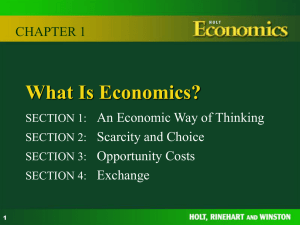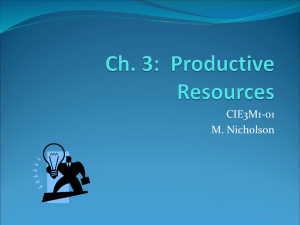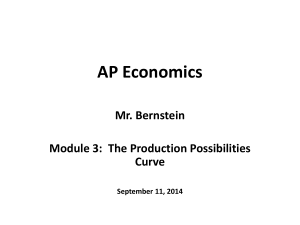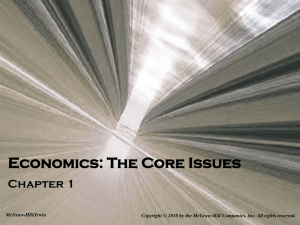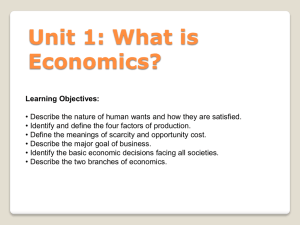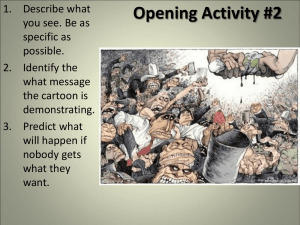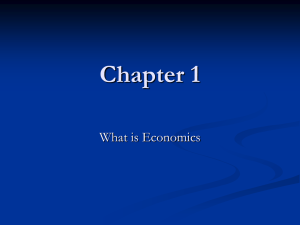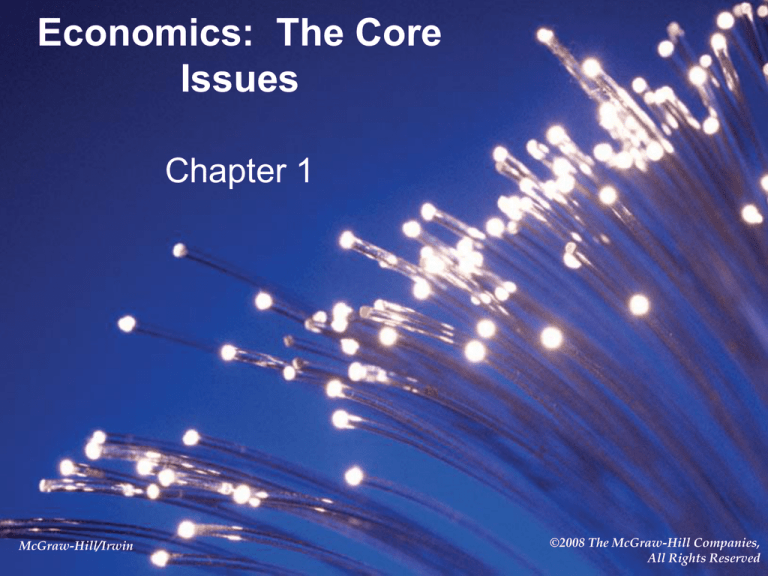
Economics: The Core
Issues
Chapter 1
McGraw-Hill/Irwin
©2008 The McGraw-Hill Companies,
All Rights Reserved
Chapter 1 –
Economics: The Core Issues
1. What is economics?
1. Scarcity.
2. The 4 Factors of Production.
3. The 3 core economic questions.
2. Opportunity Cost, & Production
Possibilities (graphing).
3. Mechanisms of Choice.
4. What Economics is all about.
2
1 – What is economics?
- Scarcity
- Factors of Production
- 3 Core Economic Questions
3
Economics
What is economics?
A social science.
4
Economics
“Ceteris paribus:”
“everything else being equal.”
the assumption that nothing else is
changing.
5
Economics
What is economics?
A social science.
Scarcity is the fundamental
concept/problem of economics.
6
Scarcity
(Scarcity:
the lack of enough resources to satisfy
all desired uses of those resources.)
LO1
7
Economics
What is economics?
A social science.
Scarcity is the fundamental
concept of economics.
Our resources are limited.
Our needs and wants are
unlimmited.
We can never meet all of our
wants and needs from our
limited resources.
8
Economics
Economics:
the study of the decisions
that people and societies
make in trying to:
fulfill unlimited wants and
needs…
…from …
limited resources.
- Or, in your book’s
words…
9
Economics
Economics is the study of how best to
allocate scarce resources among
competing uses.
Scarce Resources
Unlimmited Wants
10
Three core issues must be
resolved:
All societies must answer 3 basic
questions in the face of scarcity:
WHAT to produce with our limited
resources?
HOW to produce those goods and
services?
FOR WHOM goods and services are
produced? - that is, who will get what
we make?
LO2
11
The Economy Is Us
The economy is:
the sum of all our individual production
and consumption activities.
So…
The economy is us:
the economy is what we make and
consume.
12
Factors of Production
Factors of production:
resource inputs used to produce goods
and services:
Land
Labor
Capital
Entreprenuership
13
Factors of Production
Land refers to all natural resources
such as crude oil, water, air, forests,
minerals, etc.
Labor – not just quantity, but quality
is also important.
14
Factors of Production
Capital includes the final goods
produced for use in the production
of other goods, e.g., equipment,
structures.
Entrepreneurship is the assembling
of resources to produce new or
improved products and technologies.
15
Entrepreneurship
“…its not just a matter of what
resources you have, but also of how
well you use them…”
16
Limits to Output
No matter how an economy is
organized there is a limit to how fast
it can grow.
The most evident limit is the amount
of resources available for producing
goods and services.
LO1
17
2 – Opportunity Cost,
&
Production
Possibilities
19
Limits to Output
Scarcity …
(the imbalance between our desires and available
resources)
…forces us to make economic choices.
LO1
20
Opportunity Costs
Opportunity cost is
the most desired
goods or services
that are forgone in
order to obtain
something else.
It is what is given up
in order to get
something else.
21
Production Possibilities
Production possibilities:
the alternative combinations of final
goods and services that could be
produced considering:
a given period of time, and
using all available resources and
technology.
We must choose the actual
combination we will produce at.
22
Production Possibilities
Production possibilities CURVE:
An economic model illustrating the
concepts of:
Scarcity,
Opportunity cost (trade-offs),
The central role of choice.
(Economists use theories, or models, of
economic behavior to predict, evaluate,
and design economic policy.)
23
The Production Possibilities Curve
OUTPUT OF TRUCKS
5
A
B
4
C
3
D
2
E
1
0
1
2
3
4
5
F
OUTPUT OF TANKS
- Each point on the production possibilities
curve depicts an alternative mix of output.
24
The Production Possibilities Curve
OUTPUT OF TRUCKS
5
4
3
2
1
0
1
2
3
4
5
OUTPUT OF TANKS
- Each point on the production possibilities
curve depicts an alternative mix of output.
25
The Production Possibilities Curve
OUTPUT OF TRUCKS
5
A
B
4
C
3
D
2
E
1
0
1
2
3
4
5
F
OUTPUT OF TANKS
- Each point on the production possibilities
curve depicts an alternative mix of output.
26
Efficiency
Efficiency:
getting the maximum output of a good
from the resources used in production.
TRUCKS
Every point on a production
possibilities curves is efficient.
5
4
3
2
1
0
A
B
C
D
E
1
2
TANKS
3
4
F
5
28
Inefficiency
A production possibilities curve
shows potential output, not
necessarily actual output.
If we are inefficient, actual output
will be less than the potential output.
29
Inefficiency
(Such inefficiencies plagued centrally
planned economies.)
30
Unemployment
OUTPUT OF TRUCKS
5
A
4
B
3
Y
2
C
Unemployment
1
0
1
2
3
OUTPUT OF TANKS
4
5
32
Economic Growth
A point outside the production
possibilities curve is a combination of
goods that we are currently incapable
of producing.
33
Economic Growth
OUTPUT OF TRUCKS
5
A
X
Currently not attainable
B
4
C
3
2
1
0
1
2
3
OUTPUT OF TANKS
4
5
34
Economic Growth
The production possibilities curve shifts
outward (increases) with:
more resources, or …
better technology.
This is Economic growth:
an increase in output (real GDP) –
an expansion of production possibilities.
35
OUTPUT OF TRUCKS
Economic Growth
0
PP2
PP1
OUTPUT OF TANKS
36
Opportunity Costs
OUTPUT OF TRUCKS
5
A
B
4
Opportunity costs (“trade offs”)
C
3
D
2
E
1
0
1
2
3
4
5
F
OUTPUT OF TANKS
- Increasing the output of one good requires
sacrificing the output of other goods.
37
Law of Increasing Opportunity Costs
Law of Increasing Opportunity Costs:
Increasing quantities of one good can
only be obtained by sacrificing everincreasing quantities of other goods.
Reflected in the shape of the curve.
39
The Law of Increasing Opportunity Costs
OUTPUT OF TRUCKS
5
A
B
4
C
3
D
2
E
1
0
1
2
3
4
5
F
OUTPUT OF TANKS
- Each point on the production possibilities
curve depicts an alternative mix of output.
40
Law of Increasing Opportunity Costs
OUTPUT OF TRUCKS
5
A
Step 1: give up one truck
B
4
3
2
Step 2: get two tanks
Step 3: give up another truck
C
Step 4: get one more tank
D
E
1
0
1
2
3
4
5
F
OUTPUT OF TANKS
41
The Classic Example…
42
The Cost of North Korea’s Military
FOOD OUTPUT
A
G
P
Reduced food
output
C
O
N
Military buildup
H
MILITARY OUTPUT
D
B
43
The Cost of North Korea’s Military
North Korea’s inability to feed itself
is due in part to its large army.
Resources used for the military aren’t
available for producing food.
44
North Korea at night
The Military Share of Output
45
3 – Mechanisms of
Choice
(Economic Systems)
46
The Mechanisms of Choice
An economy is largely defined by
how it answers the WHAT, HOW and
FOR WHOM questions.
The two major systems are:
Market system,
Command system.
LO3
51
The Invisible Hand of a Market
Economy
The market mechanism is the use
of market prices and sales to signal
desired outputs (or resource
allocations).
LO3
52
The Invisible Hand of a Market
Economy
What to make:
The market decides the mix of output
in an economy through the forces of
supply and demand.
How to make:
Competition for profits prompts
producers to seek efficient methods.
Who receives what is produced:
LO3
Those who produce (market value)
receive a commensurate share of the
production.
53
The Invisible Hand of a Market
Economy
Laissez faire — the doctrine of
nonintervention by government in the
market.
Adam Smith – The Wealth of Nations
– 1776.
Individuals pursuing their own interests
also benefit society by seeking
efficient production in pursuit of profits
under competition.
The “invisible hand” of the market.
LO3
54
The Invisible Hand of a Market
Economy
Government
intervention only
interferes with and
compromises the
natural efficiency and
productivity of the
market.
Adam Smith
LO3
55
The Invisible Hand of a Market
Economy
LO3
57
Government Intervention and
Command Economies
Karl Marx argued that the
government not only had to intervene
but had to own all the means of
production.
Markets permit capitalists to enrich
themselves and exploit the
proletariat who toil long hours for
subsistence wages.
LO3
58
Government Intervention and
Command Economies
John Maynard Keynes offered a
less drastic solution.
In Keynes’ view,
government should play
an active but not an allinclusive role in
managing the economy.
LO3
59
A Mixed Economy
Mixed economy:
uses both market signals and
government directives to allocate goods
and resources.
Most economies are mixed
economies.
LO3
60
Continuing Debates
The core of most debates is some
variation of the WHAT, HOW, or FOR
WHOM questions.
Conservatives favor Adam Smith’s
laissez-faire approach.
Liberals tend to think government
intervention is likely to improve the
answers.
LO3
61
A Mixed Economy
64
Market Failure
Reliance on market signals don’t
always lead to optimal outcomes.
Suboptimal results can include:
Undesirable output mix.
Unemployment.
Pollution.
Many more…
This is known as market failure.
65
66
Government Failure
Government intervention may move
us closer to our economic goals or it
may fail.
Government failure:
government intervention that worsens
(or fails to improve) economic
outcomes.
67
A Mixed Economy
68
Seeking Balance
The challenge for society is to
minimize failures by selecting the
appropriate balance of market
signals and government directives.
69
4 – What Economics is
all about.
71
What Economics Is All About
The basic purpose of studying
economics is understanding how
economies function:
How an economy is organized,
how it behaves, and
how successfully it achieves it basic
objectives.
72
End Versus Means
Economists don’t formulate an
economy’s objectives...
…Politicians and the political
process do.
Economists focus on the means
available for achieving given goals.
73
So….
Economists focus on factual analysis
and explanation of the economy:
Ex: what the monetary cost of a
providing health care will be, who would
bear the burden under a given plan.
Politicians and the public debate and
make values choices:
Ex: If the costs (the trade-offs) are
acceptable, and if the assignment of the
burden is fair or reasonable.
74
Macro Versus Micro
Macroeconomics is the study of
aggregate economic behavior, of the
economy as a whole.
Microeconomics is the study of
individual behavior in the economy,
of the components of the larger
economy.
75
Theory Versus Reality
Economists use theories, or models,
of economic behavior to evaluate and
design economic policy.
In these theories, we typically ignore
the possibility that many things can
change at one time.
Ceteris paribus is the assumption
that nothing else is changing.
76
Imperfect Knowledge
We may never find an absolute
truth, because the inner workings of
the economy change over time.
77
Economics: the Core
Issues
End of Chapter 1
McGraw-Hill/Irwin
©2008 The McGraw-Hill Companies,
All Rights Reserved



